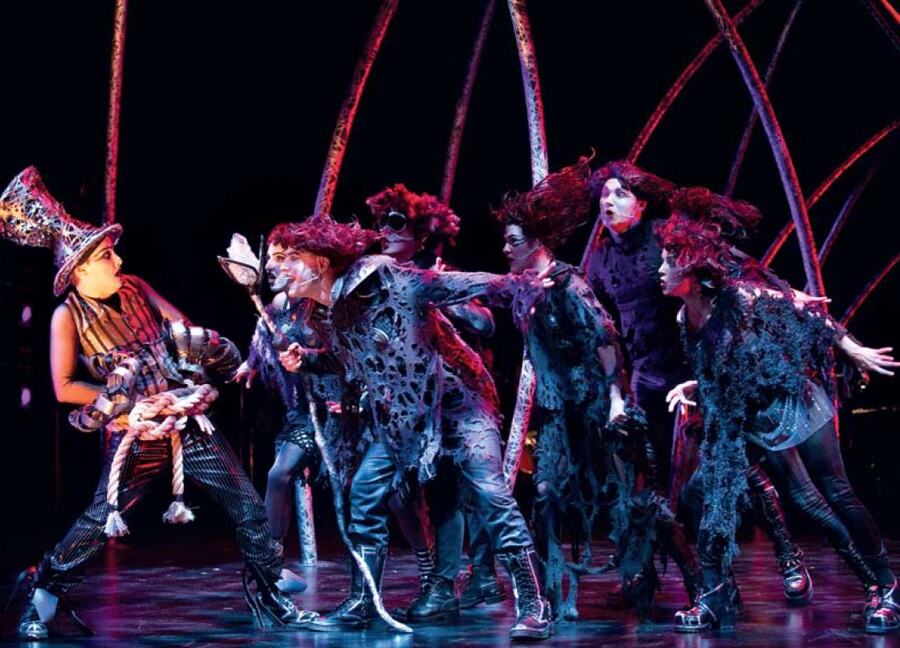Jonathan Christenson, ADAPTATION, DIRECTION, MUSIC: The Hunchback of Notre Dame is a much-adapted story, and at first, I had some doubts about giving it a musical treatment. Previous adaptations have focused on the romance between Quasimodo and Esmeralda, while vilifying the priest Claude Frollo. But we wanted to take the audience through his journey, of a good man with high ideals who is brought to his knees by love, and how it leads him to do things that he never thought he was capable of. This show was the third part of a trilogy we did called “The Gothic Trilogy”—the previous ones were Frankenstein and Nevermore. We were drawn to the notion of taking these timeless stories, and finding more contemporary expressions for them. Imagine that you were to take someone who just read one of these novels, and had a dream about it…that’s the place we were trying to build our world from.
Both Bretta and I wanted to create a dream world in which the characters look larger than life. When the curtain comes up, you know you’re in another world—this is not a world ruled by the logic of the everyday, it’s the world of the dream. We used music and visual design to create the foundation for how the piece unfolds. The cathedral of Notre Dame was at the center. We also wanted to be able to travel through Paris, since the story takes place all across the city; we didn’t want a dozen scene changes. Utilizing the underlying notions of Gothic architecture, we came down to this suggestion of the arch that is repeated across the proscenium [right photo], and the suggestion of the nave of the cathedral. Rather than try to evoke the period’s world of stone, we opted for a steel world, which had a tie to the 20th century. We were trying to find the meeting ground between then and now.
Catalyst Theatre is a small company and we develop our productions in a warehouse that can seat around 100 people. But most of our work tends to play in theatres that have 500–1,500 seats; our casts tend to be no bigger than 8 people. The main challenge for us in Hunchback was finding a style and approach that would evoke a sense of that huge scale.

Bretta Gerecke, DESIGN: Jonathan and I wanted Hunchback to feel gritty, current and not like a period piece. We tended to use a lot of found materials—papers, plastics and things—and with this concept of decomposing, the “stringiness” of the characters started to evolve. Above left is Jehan Follo [Claude Frollo’s brother] being captured by the gypsies—his cuffs are made of insulation foam and his top hat is made of construction fabric that’s usually used in big scenic backdrops, glue and string. His costume is covered in gorilla tape, duct tape and matte black fabric tape. For the gypsies, I took $5 or $10 Halloween wigs and dunked them in flex glue, then I hung them upside down so gravity pulled all the hair to the ground. I then flipped them right side up when dry and mashed them into different styles. The clothes were from Goodwill and Value Village—cheap and nasty old sweaters or old knit things that we just destroyed with cutting (I think one of our tools was a barbeque fork). [Laughs] Everything is done by hand but not in a beautiful, fine sewing way—it’s more of a massacre! We tended to use a lot of saturated colors and side light, so the overall style of Hunchback was exaggerated to begin with. Everything else, including costumes, had to reach that height of style.
On the right, you see the series of arches that make up the set, which we used in a variety of ways. We lit them in ways that allowed for transformation. Sometimes, they were the backdrop to the town square; at others, a little window from which Quasimodo is looking down on the square; or they were part of Esmeralda’s dance sequence—kind of like a gypsy rock show! The bells of Notre Dame [also right] also played a huge part in the show—they keep Quasimodo alive, essentially. Here, they were flat pieces that started out as line drawings—I just played with line weight to make them look three-dimensional. They follow the jagged edges of the rest of the production. They have a gauzy fabric on them and there was lighting diffusion, so they could glow. I hope I’m managing to explain this. You’re talking about a dreamscape that doesn’t make sense logically, so it’s very difficult to articulate!
Hunchback, produced by Catalyst Theatre in Edmonton, Canada, toured for almost exactly one year (March 11, 2011–March 10, 2012). It was adapted and directed by Jonathan Christenson from The Hunchback of Notre Dame by Victor Hugo. Christenson also composed the music. The production featured design by Bretta Gerecke; choreography by Laura Krewski; sound design by Wade Staples; lighting by Narda McCarroll; music direction (in Edmonton) by Don Horsburgh; music direction (in Vancouver) by Ryan Sigurdson; costume, prop and set building by Sheena Haug, Amy Kucharuk and Daniela Masellis; voice and text coaching by Betty Moulton; production management by James Robert Boudreau; stage management (in Edmonton) by John Raymond; stage management (in Vancouver) by Jan Hodgson. The production was commissioned by Edmonton’s Citadel Theatre.


